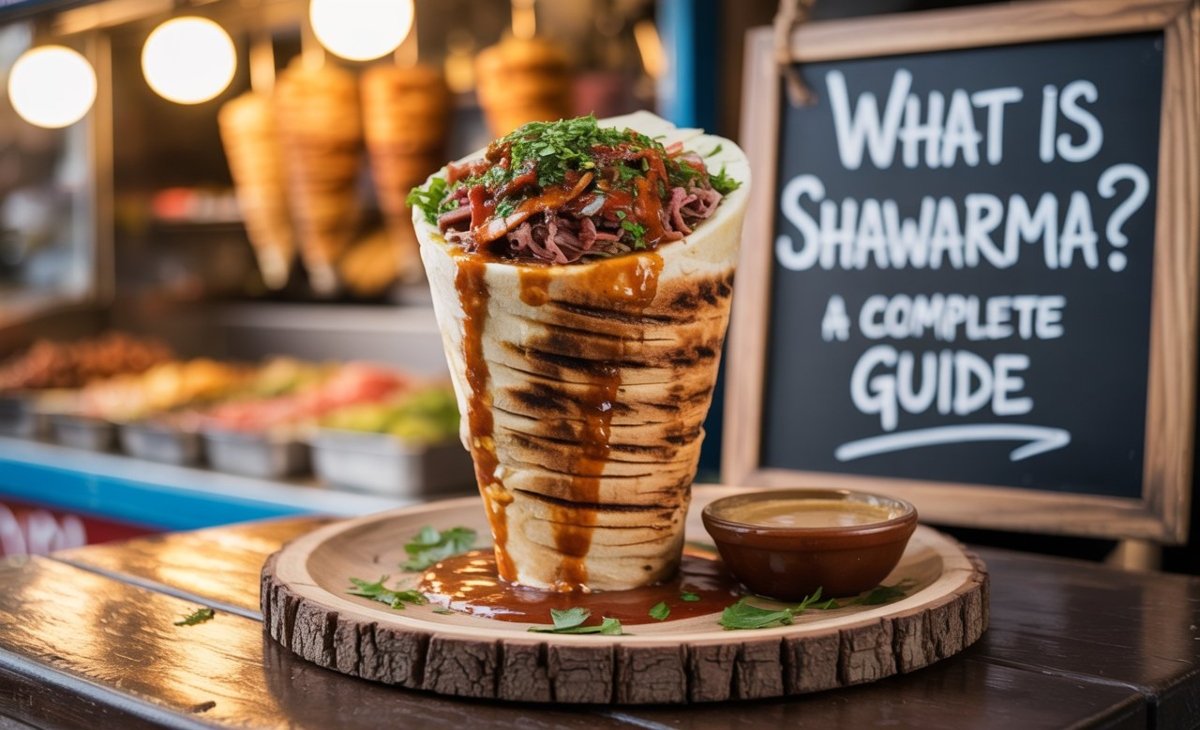If you’ve ever strolled past a food truck and caught a whiff of spiced meat roasting on a vertical spit, you’ve likely encountered shawarma. But what is shawarma exactly? More than just a meal, shawarma is a cultural symbol, a culinary tradition, and a global street food favorite. Juicy, tender meat, wrapped in warm pita with tangy sauces and crisp veggies, makes shawarma irresistible. In this guide, we’ll explore its origins, ingredients, variations, and why it continues to win hearts worldwide.
What Is Shawarma?
Shawarma is a Middle Eastern dish made of thinly sliced meat slowly cooked on a vertical rotisserie. Traditionally, lamb was the star, but today chicken, beef, turkey, and veal are also popular. The meat is marinated in a blend of spices—garlic, cumin, turmeric, paprika, and cinnamon—before being stacked and roasted for hours. As the outer layer crisps, thin slices are shaved off and tucked into flatbread or served on plates with sides.
This cooking method doesn’t just make the meat juicy and tender—it infuses every bite with smoky, spiced flavors. It isn’t just food; it’s an experience that combines aroma, taste, and culture.
The Origins of Shawarma
To understand what shawarma is today, we need to look at where it came from. Shawarma’s roots trace back to the Ottoman Empire in the 19th century. It evolved from the Turkish dish “doner kebab,” which also used stacked, rotating meat. As the dish spread across the Middle East, each country added its twist—different meats, marinades, and sauces.
From Damascus to Cairo, shawarma became a street food staple. Immigrants then carried it to Europe, North America, and beyond. Today, shawarma shops are found in nearly every major city, serving hungry crowds day and night.
What Is Shawarma Made Of?
At its core, shawarma combines three essential elements: meat, bread, and toppings. Each component is customizable, making shawarma as diverse as the regions it’s found in.
The Meat
- Chicken Shawarma – The most popular worldwide, tender and mildly spiced.
- Beef Shawarma – Rich, hearty, and flavorful.
- Lamb Shawarma – Bold and traditional, especially in Middle Eastern countries.
- Turkey Shawarma – Lean yet tasty, popular with health-conscious eaters.
- Veal Shawarma – Delicate, soft, and less fatty than beef.
The Wrap
Warm pita bread or laffa (a soft, fluffy flatbread) holds everything together. Some regions use saj bread or tortillas for a twist.
The Sauces
Creamy garlic sauce, tangy tahini, or spicy chili sauce bring balance to the savory meat. Each bite is a mix of flavors—rich, tangy, and sometimes spicy.
The Toppings
Fresh cucumbers, tomatoes, onions, parsley, lettuce, and crunchy pickles provide texture and freshness. These toppings cut through the richness of the meat.
Why Shawarma Matters
So, why is shawarma more than just food?
- Cultural Connection – It tells the story of migration and tradition. It’s a dish that connects people to their roots.
- Accessibility – Affordable and widely available, it is a go-to meal for students, workers, and travelers.
- Flavor Explosion – Few dishes balance smoky, tangy, creamy, and crunchy as perfectly as shawarma.
- Global Appeal – From New York to Dubai, it’s loved by millions across cultures.
Simply put, It matters because it’s comfort food with history and flavor packed into every bite.
Shawarma as Street Food
Walk down any busy street in Beirut, Istanbul, or Karachi, and you’ll see crowds around shawarma stands. Vendors slice sizzling meat while the smell of spices drifts through the air. In many cultures, grabbing a shawarma after work or late at night is a tradition.
Street shawarma is fast, affordable, and filling, but it’s also social. Friends share wraps, families enjoy plates, and foodies explore regional variations. That’s why shawarma isn’t just a dish—it’s part of everyday life.
Classic Sides for Shawarma
It rarely comes alone. Some classic sides elevate the meal:
- Garlic Sauce (Touma): Creamy, garlicky, and bold—it’s the soul of shawarma.
- Hummus: Smooth and savory, offering a nutty contrast.
- Tahini Sauce: Nutty sesame paste, often paired with beef shawarma.
- Pickled Vegetables: Crunchy cucumbers, carrots, and turnips for tang.
- Fresh Salad: Tomatoes, onions, and parsley for a refreshing bite.
- French Fries: A modern favorite, sometimes tucked directly into the wrap.
Each side adds balance, making it a complete and satisfying meal.
Tips for Enjoying
- Try different meat options to find your favorite.
- Pair it with fresh sides like pickled veggies to balance richness.
- If making at home, marinate the meat overnight for maximum flavor.
- For a lighter option, skip fries and use whole wheat pita.
Final Words
So, what is shawarma? It’s more than just roasted meat—it’s a dish that carries history, culture, and flavor in every bite. From its Ottoman roots to today’s global street food fame, shawarma continues to bring people together over delicious, satisfying meals. Whether you enjoy it wrapped in warm pita or served on a plate with classic sides, shawarma is always a flavor-packed experience worth trying.
If you haven’t tasted it yet, now’s the perfect time to grab one from a local stand—or try making it at home. It isn’t just food; it’s an adventure.
Common Questions About Shawarma
Is Shawarma Healthy?
It can be healthy if made with lean meats and plenty of veggies. However, sauces and fries add calories, so moderation is key.
How Is Shawarma Different From Gyro or Doner Kebab?
All three use vertical rotisseries, but flavors differ. Gyros (Greek) use pork or chicken with tzatziki, while doner kebab (Turkish) uses lamb or beef. It is spicier, with Middle Eastern seasonings.
Can You Make Shawarma at Home?
Yes! While you may not have a rotisserie, you can marinate meat with shawarma spices, grill it, and wrap it in pita with veggies and garlic sauce.
Why Does Shawarma Taste So Unique?
The secret lies in the marinade. A mix of cumin, turmeric, cinnamon, cardamom, and garlic creates that unmistakable flavor profile.





